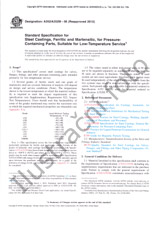Potřebujeme váš souhlas k využití jednotlivých dat, aby se vám mimo jiné mohly ukazovat informace týkající se vašich zájmů. Souhlas udělíte kliknutím na tlačítko „OK“.
ASTM E3358-23
Standard Guide for Per- and Polyfluoroalkyl Substances Site Screening and Initial Characterization
Přeložit název
NORMA vydána dne 1.2.2023
Informace o normě:
Označení normy: ASTM E3358-23
Poznámka: NEPLATNÁ
Datum vydání normy: 1.2.2023
Kód zboží: NS-1142761
Počet stran: 23
Přibližná hmotnost: 69 g (0.15 liber)
Země: Americká technická norma
Kategorie: Technické normy ASTM
Anotace textu normy ASTM E3358-23 :
Keywords:
AFFF, conceptual site model, corrective action, exposure pathways, initial site characterization, munitions, PFAS, risk assessment, site-screening, stack emissions,, ICS Number Code 71.040.50 (Physicochemical methods of analysis)
Doplňující informace
| Significance and Use |
|
4.1?PFAS are widely used in commercial and industrial applications worldwide (see Fig. 1). PFAS are of concern due to their documented persistence and their studied impacts on human health and the environmental. While there is no comprehensive source of information on the many individual PFAS substances and their functions in different applications, a range of resources are available to the practitioner. This guide provides information to assist the practitioner in navigating these challenges during the initial screening and site characterization process. FIG. 1?Activity/Industry that may be Sources of PFAS Use and Release 4.2?The 4.3?Multi-step Risk Management Framework:? 4.3.1?The actions described in this guide are intended to provide a multi-step risk management framework to confirm, with reasonable certainty, that PFAS may have been used at a federally-owned, publicly-owned, or privately-owned property. This standard provides guidance on how to focus limited resources on using a multi-step process, illustrated in Fig. 2, to identify property potentially impacted by on-site or off-site uses and releases of PFAS. Section 4.5 describes the use and occurrence of FIG. 2?Initial Site Screening and Characterization Flow Diagram 4.4?PFAs History and Use:? 4.4.1?In the 1940s, industrial processes to commercially produce 4.4.2?Release of PFAS during manufacture into the atmosphere may have occurred, and may be continuing to occur, followed by subsequent redeposition of PFAS materials on land where PFAS can enter surface water and groundwater. Other potential sources of PFAS emissions are dry cleaning and commercial laundry operations where clothing coated with 4.4.3?Broadly, consumer and industrial uses of 4.5?PFAs Use and Occurence:? 4.5.1?PFAS containing chemicals have been used in a broad spectrum of federal and commercial activities, as illustrated in Fig. 1. The use of 4.6?Government and Military Installations Use of PFAs:? 4.6.1?PFAS have been used in a variety of applications at government/military facilities, including as a component in 4.6.2?Current and historical AFFF storage and transfer areas at federally-owned facilities are of potential concern for 4.6.2.1?Accordingly, key elements for identifying significant PFAS sources at federally-owned facilities are the storage and use of AFFF. PFAS from AFFF used in firefighting and fire suppression systems are considered to have the greatest potential for 4.6.2.2?Other potential sources of 4.6.3?AFFF used in Fire-Fighting Exercises and Fire Suppression are water-based (60-90%) and frequently contain hydrocarbon-based surfactants, such as sodium alkyl sulfate, and fluorosurfactants, such as fluorotelomers, PFOA, and/or PFOS. 4.6.3.1?Companies including 3M, DuPont, Ansul, and Chemguard were the primary fire-fighting foam producers that used fluoro-chemical surfactants in the production of AFFF. Typically, AFFF concentrate was proportionally mixed into water lines using in-line eductors or other proportioning devices to create the necessary foam solution ranging from 3 % to 6 % of the concentrate. As noted, AFFF was primarily used with Class B fuel fires because the chemical properties of PFAS in AFFF created a thick foam blanket. Class A fire-fighting foams were used to extinguish wood and grass fires and do not contain PFAS. 4.6.4?Open Burning / Open Detonation of MunitionsOpen burning and open detonation of munitions are non-routine activities at some military installations and federal facilities. The types of munitions that may contain Note 1:?If the open detonation activities are conducted are part of the installations training program, they may not be subject to permitting under RCRA Subpart X. Temperatures in munitions deactivation furnaces and rotary kilns reach up to 1500?F, which may not be adequate to destroy PFAS (EPA, 2005). Open burning may not achieve temperatures high enough to destroy PFAS. The incomplete combustion of munitions as well as thermal deactivation releases PFAS into the air. Emissions associated with 4.6.5?Electroplating, specifically hard chromium plating, is an industrial activity where PFAS-containing mist suppressants may have been used. 4.6.6?Landfill Operations, Waste Disposal Areas, and Wastewater Treatment PlantsHistorically, landfills received wastes generated from government/military installations, including waste streams from operational areas (machine shops, electroplating operations, etc.), housing areas, and waste from wastewater treatment plants. These waste streams may contain industrial and/or consumer products that were either manufactured with PFAS or contain compounds that, when they degrade, 4.7?Commercial and Industrial Uses of PFAs:? 4.7.1?Uses of PFAS in commercial applications are varied and span numerous commercial and industrial sectors (Gaines 2022) 4.7.1.1?Chemical industry with a special focus on processing aids in the polymerization of fluoropolymers, 4.7.1.2?Surface protection of textile, apparel, leather, carpets, and paper, 4.7.1.3?Electronics industry (semiconductors and wire; NAICS 334400 and 335929, respectively) (Note: and solar panels), 4.7.1.4?Consumer and personal care products, 4.7.1.5?Food processing and packaging, 4.7.1.6?Plastics and rubber production, 4.7.1.7?Pulp and paper industry, 4.7.1.8?Coatings, paints, and varnishes, 4.7.1.9?Refinery and petrochemical industry, 4.7.1.10?Munitions and explosives production, 4.7.1.11?Aircraft and heavy equipment manufacturing, 4.7.1.12?Public-sector and private-sector airports, and 4.7.1.13?Electroplating of parts and components. 4.7.2?As noted in section 4.6.5, electroplating, specifically hard chromium plating, is an industrial activity where PFAS-containing mist suppressants may have been used. 4.7.3?Chemical industry with a special focus on processing aids in the polymerization of fluoropolymers. Important uses of PFAS in the chemical industry are their uses as processing aids in the polymerization of fluoropolymers, the production of chlorine and sodium hydroxide, and the production of other chemicals including solvents. PFAS that are used as processing aids in the polymerization of fluoropolymers are of special concern due to emissions and toxicity (Lohmann, 2020) (5). 4.7.4?Surface Protection of Textile, Apparel, Leather, Carpets, and PaperConsiderable quantities of PFAS, especially of side-chain fluorinated polymers, have been used as surface protectors in textile, apparel, leather, carpets, and paper. Paper products that may contain Note 2:?Toxicological and ecotoxicity assessments of perfluoroalkyl acids are in their nascent stage. 4.7.5?Electronics IndustryPFAS have been used as components in electronic devices (for example, in flat panel displays or liquid crystal displays). PFAS have also been used for the testing of electronic devices and equipment, as heat transfer fluids/cooling agents, in cleaning solutions, to deposit lubricants, and to etch piezoelectric ceramic filters. PFAS are also used in the production of semiconductors and wiring. 4.7.6?Plastics and Rubber ProductionPFAS have been used as mold release agents, foam blowing agents, foam regulators, polymer processing aids, plastic etching agents, anti-blocking agents for rubber, and curatives in the production of plastic and rubber. Fluoropolymers can increase the processing efficiency and quality of plastic and rubber. The use of 4.7.7?Coatings, Paints, and VarnishesLarge amounts of fluoropolymers have been used in coatings and paints to impart oil- and water-repellency. Fluoropolymers are also used as anti-stick and anticorrosive coatings. 4.7.8?Refineries and Petrochemical IndustriesAs noted previously, AFFF containing PFAS has been used for fire suppression at petroleum refineries, petrochemical manufacturing operations, and bulk 4.7.9?Munitions and Explosives ProductionPFAS is used in a small percentage of energetics as binders and oxidizers, and in some military munitions for liners, o-rings, or other components (SERDP 2020) (7). Manufacturers of munitions have historically released PFAS through open-burning of munition waste. 4.7.10?Aircraft and Heavy Equipment ManufacturingIndustries that use electroplating in the production and manufacturing of parts and equipment may have used PFAS-containing chemicals. 4.7.11?Public-Sector and Private-Sector Airports4.7.12?CarwashesPFAS are a component of the soap and waxes at commercial car washes (NAICS code 811192). Sumps and catch basins at a carwash that have lost their structural integrity may be a source of 1.1?Per- and polyfluoroalkyl substances (PFAS) are a group of over 7,000 manmade compounds consisting of polymeric chains of carbon bonded to fluorine atoms, usually with a polar functional group at the head. This guide recognizes that PFAS can be categorized as polymeric or nonpolymeric, collectively amounting to more than 4,700 Chemical Abstracts Service (CAS)-registered substances. Environmental concerns pertaining to PFAS are centered primarily on the perfluoroalkyl acids (PFAA), a subclass of per-and polyfluoroalkyl substances, which display extreme persistence and chain-length dependent bioaccumulation and adverse effects in biota. 1.2?The regulatory framework for PFAS continues to evolve, both domestically and internationally. The United States Environmental Protection Agency (EPA) is proceeding with a wide-ranging set of 1.3?Hazardous waste treatment, storage, and disposal facilities (TSDF) currently operating under the Resource Conservation and Recovery Act (RCRA) via a Part B Permit may be ordered to investigate 1.4?Numerous states and Tribes are using their existing regulatory programs to direct investigation, site remediation, and correction action related to releases of PFAS to soil, groundwater, and surface waters. These actions range from health advisories and guidelines to enforceable regulatory standards. Regulatory considerations include 1.5?This guide assists 1.6?This guide does not constitute All Appropriate Inquiries as defined in 40 CFR Part 312 and is not intended to provide the user with any of the landowner liability protections codified in CERCLA ?101(35)(A)(i), CERCLA ?101(40)(B)(iii), or CERCLA ?107(q)(1)(A)(viii).. 1.7?This guide describes widely accepted considerations and best practices used in the site screening and initial site characterization process, with specific consideration of the potential for the 1.8?This guide does not address and is not applicable to sampling and analysis of public or private domestic water supply systems subject to regulation under the Safe Drinking Water Act and state private well testing act requirements. Regulatory agencies responsible for implementing the Safe Drinking Water Act may have established sampling and reporting requirements for public, community, and privately operated water systems. 1.9?All references to specific federal or state programs are current as of the date of publication. The user is cautioned not to rely on this guide alone but to consult directly with the appropriate program and legal counsel regarding this complex and rapidly evolving concern. 1.10?This guide is intended to complement, not replace, existing regulatory requirements or guidance. ASTM International (ASTM) guides are not regulations; they are consensus-based standards that may be followed as needed. 1.11?UnitsThe values stated in SI units are to be regarded as the standard. Other units, such as fractional units of parts per billion (ppb) and parts per trillion (ppt), are also included in this guide. 1.12?This standard does not purport to address all of the safety concerns, if any, associated with its use. It is the responsibility of the user of this standard to establish appropriate safety, health, and environmental practices and determine the applicability of regulatory limitations prior to use. 1.13?This international standard was developed in accordance with internationally recognized principles on standardization established in the Decision on Principles for the Development of International Standards, Guides and Recommendations issued by the World Trade Organization Technical Barriers to Trade (TBT) Committee. |
Odebírejte informace o nově vydaných normách ZDARMA:
Chcete pravidelně odebírat informace o nově vycházejících normách z celého světa a to zcela zdarma?
Přihlašte se k odběru. Vše je velice jednoduché a absolutně ZDARMA.
Na výběr máte vydavatele z celého světa.




 Cookies
Cookies
